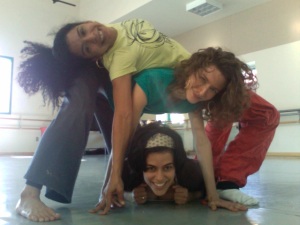I’m sitting in a workshop rehearsal with the three latina dance artists, Sita Frederick, Anita “Rokafella” Garcia and Marion Ramirez. Jane Gabriels, the director of the Bronx based arts group Pepatian, is also there acting as coach, responder and inside eye for the explorations into “race.” This is not the “ethnicity” kind of race, although that does play a role in the work of the group. This race is a playful metaphor on race as in competing to get ahead. But they are moving in slow motion and shifting dance forms fluidly from body to body and around the room. Each dancer embodies a different style; Sita is Afro-Cribbean, Roka is Hip Hop, and Marion brings a constantly morphing style of improvisation that easily imitates and mirrors the other styles with an etherial other worldness that is impossible to describe.
I’m thinking to myself, this is really what it is all about; dancers in a studio working together, laughing and playing, making fun of themselves and each other. Someone says; “let’s keep that, I like that,” or “don’t you dare try to put that in this piece….that is not gonna happen.” Then they “run through” a small portion of what they’ve been working on. Wow, that is so much more than what I expected. Where did all those subtle nuances come from? Where did they get that?
I hear that they have been “writing” as part of their process. At first, I assume they are doing script work, but later Marion clarifies that the writing is an exercise done to help get deeper into emerging subject matter and open new avenues of exploration. Someone gives a word and everyone literally “writes” for fifteen minutes whatever comes to mind, a free association flow of written images, thoughts, memories or daydreams. Conversations are generated, new ideas bloom, and the work continues.
Each dancer comes from different movement and cultural traditions, but they share the bond of Latina culture as it has evolved and changed and settled into the New York City area. Identity is shaped not just by cultural and circumstantial conditions. For a dancer, identity is shaped by the dances one grows up with and also the dances one chooses to study and develop within an aesthetic discipline. African Diasporic movement forms are as wide-ranging and diverse as the thousands of Caribbean islands and other locations in North and South America where the African dances first arrived. These histories and evolutions are the materials of Out of La Negrura. And it is also a new world of movement where global communication allows dance forms to travel via “the Web” in seconds rather than decades or perhaps even centuries.
On Friday October 31 from 3-4pm, the performers will informally present the week’s work in a lecture/demonstration in the Schwartz Center’s Class of ‘ 56 Dance Theater. The intention is not to present a finished product, but show and tell about the process itself as well as the material generated from a week of working intensely.
56 Dance Theater. The intention is not to present a finished product, but show and tell about the process itself as well as the material generated from a week of working intensely.
This is not the first time these three artists have come together, nor is it the first time they have been in residence at the Schwartz. Each of the performers has a very separate life that includes touring nationally and internationally. They come together for an extended residency situation whenever possible, usually once a year or so. In May 2005, Out of La Negrura was presented as a full performance piece accentuating the very different styles of the individual artists and group choreography with all it tensions and overlaps.
Out of La Negrura translates from Spanish as “Out of Blackness.” Blackness in this case is not just racial histories, but “blackness” in all its implications and interpretations. This new chapter being developed at Cornell promises to be as rich and provocative as ever.



